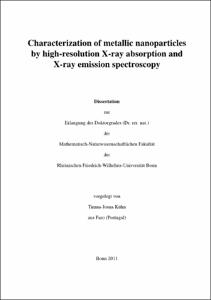Characterization of metallic nanoparticles by high-resolution X-ray absorption and X-ray emission spectroscopy

Characterization of metallic nanoparticles by high-resolution X-ray absorption and X-ray emission spectroscopy

| dc.contributor.advisor | Hormes, Josef F. | |
| dc.contributor.author | Kühn, Timna-Josua | |
| dc.date.accessioned | 2020-04-17T19:24:25Z | |
| dc.date.available | 2020-04-17T19:24:25Z | |
| dc.date.issued | 16.03.2012 | |
| dc.identifier.uri | https://hdl.handle.net/20.500.11811/5259 | |
| dc.description.abstract | In almost all areas of technology, metallic nanoparticles are of interest due to their special thermal, electronic, magnetic and optical properties. Their special properties are mainly due to their small size which implies the relevance of quantum effects as well as the significance of the surface: For 2 nm nanoparticles, the surface-to-volume ratio is already 1 : 1. However, the identification of surface-to-volume interactions – that are responsible for the new properties – is a difficult task due to the small size that inhibits a lot of `standard' techniques to be applicable. Here X-ray absorption/emission spectroscopy (XAS/XES) is a favorable tool for the characterization of nanoparticles, independent on size, degree of crystallinity and shape/condition of the surface. Using XAS, a tempered nanosized Co3Pt/C catalyst have been investigated. Its outstanding oxygen-reduction reaction (ORR) properties in a fuel cell could be related to a lowered Pt 5d-band center connected to a tightened Pt–Pt bonding distance, leading to a weakening of the oxygen adsorption strength so that the ORR may proceed faster. One drawback remains, however, as the properties found by (standard) XAS are summed up for different chemical environments of the chosen element. Thus, no distinction can be made between, e.g., the pure metal in a nanoparticles' interior and the ligated metal in the outer shells or surface. Here, high-resolution fluorescence-detected XAS (HRFD-XAS) provides additional opportunities as, due to its chemical sensitivity, it leads to site-selective XAS. For a system of 6 nm sized Co nanoparticles, build up of a metallic core surrounded by a protecting shell, that resulted from the `smooth oxidation' process, this technique of site-selective XAS was proven to be applicable. For the first time, the interior and outer shell of a metallic nanoparticle could be characterized separately. In particular, the Co-hcp phase could be determined for the highly crystalline metallic core with lattice constants similar to bulk Co. For the outer shell, the thickness of 1 to 3 monolayers, local structure and type of ligands – Co(II)O, Co(II)CO3, Co(III)N – could be identified. In principle this technique also allows to identify the interaction of core and shell of a nanoparticle, if it effects its electronic/geometric properties. | |
| dc.language.iso | eng | |
| dc.rights | In Copyright | |
| dc.rights.uri | http://rightsstatements.org/vocab/InC/1.0/ | |
| dc.subject | Röntgenabsorptionsspektroskopie | |
| dc.subject | Röntgenemissionsspektroskopie | |
| dc.subject | Orts-Selektivität | |
| dc.subject | metallische Nanoteilchen | |
| dc.subject | Katalysator | |
| dc.subject | Brennstoffzelle | |
| dc.subject | XAS | |
| dc.subject | XES | |
| dc.subject | XANES | |
| dc.subject | EXAFS | |
| dc.subject | site-selectivity | |
| dc.subject | metallic nanoparticles | |
| dc.subject | catalyst | |
| dc.subject | fuel cell | |
| dc.subject.ddc | 500 Naturwissenschaften | |
| dc.subject.ddc | 530 Physik | |
| dc.subject.ddc | 540 Chemie | |
| dc.title | Characterization of metallic nanoparticles by high-resolution X-ray absorption and X-ray emission spectroscopy | |
| dc.type | Dissertation oder Habilitation | |
| dc.publisher.name | Universitäts- und Landesbibliothek Bonn | |
| dc.publisher.location | Bonn | |
| dc.rights.accessRights | openAccess | |
| dc.identifier.urn | https://nbn-resolving.org/urn:nbn:de:hbz:5n-27329 | |
| ulbbn.pubtype | Erstveröffentlichung | |
| ulbbnediss.affiliation.name | Rheinische Friedrich-Wilhelms-Universität Bonn | |
| ulbbnediss.affiliation.location | Bonn | |
| ulbbnediss.thesis.level | Dissertation | |
| ulbbnediss.dissID | 2732 | |
| ulbbnediss.date.accepted | 27.10.2011 | |
| ulbbnediss.fakultaet | Mathematisch-Naturwissenschaftliche Fakultät | |
| dc.contributor.coReferee | Linden, Stefan |
Dateien zu dieser Ressource
Das Dokument erscheint in:
-
E-Dissertationen (4077)




